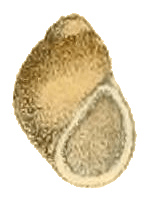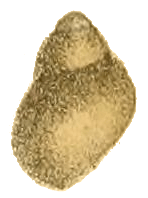Pachydrobiella brevis facts for kids
Quick facts for kids Pachydrobiella brevis |
|
|---|---|
 |
|
| Drawing of apertural view of the shell of Pachydrobiella brevis | |
| Scientific classification | |
| Kingdom: | |
| Phylum: | |
| Class: | |
| (unranked): |
clade Caenogastropoda
clade Hypsogastropoda clade Littorinimorpha |
| Superfamily: |
Rissooidea
|
| Family: |
Pomatiopsidae
|
| Subfamily: |
Triculinae
|
| Tribe: |
Jullieniini
|
| Genus: |
Pachydrobiella
Thiele, 1928
|
| Species: |
P. brevis
|
| Binomial name | |
| Pachydrobiella brevis (Bavay, 1895)
|
|
| Synonyms | |
|
Pachydrobia brevis Bavay, 1895 |
|
Pachydrobiella brevis is a tiny freshwater snail. It's a type of water animal that belongs to a group called gastropods, which are mollusks. This snail is part of the Pomatiopsidae family. Interestingly, Pachydrobiella brevis is the only known species in its entire group, called the Pachydrobiella genus.
Contents
Where Does This Snail Live?
This special snail, Pachydrobiella brevis, is found in a specific place. It lives on Khong Island, which is located in the Mekong River in southern Laos. Khong Island is known as the snail's "type locality." This means it's the first place where scientists officially found and described this species. It's thought that this snail lives only in the Khong Island area, making it an endemic species.
What Does This Snail Look Like?
The shell of Pachydrobiella brevis has an oval or cone-like shape. It is quite thick and feels very smooth. This smooth shell is special because most other snails in its group (the Jullieniini tribe) have shells that are not smooth. The outer edge of the shell's opening is also thick and has lines that show how the snail grew over time.
Shell Size
The shell of this snail is small. It measures about 2.5 millimeters wide. Its height can range from 2.2 to 3.6 millimeters.
Snail's Teeth
Scientists have studied the snail's radula, which is like a tongue with tiny teeth. Early drawings by scientists like Thiele (in 1928) and Brandt (in 1970) showed these teeth as smooth. However, later research by Davis (in 1979) found that the radula actually has many rows of teeth, not just smooth ones.
How Does This Snail Live?
Pachydrobiella brevis mostly lives in freshwater places. These places usually have no strong current, or only a very gentle one. Sometimes, though, this snail can also be found in areas where the water moves moderately or even very fast, like in whitewater.
This snail likely eats algae that grow on stones in the water.


